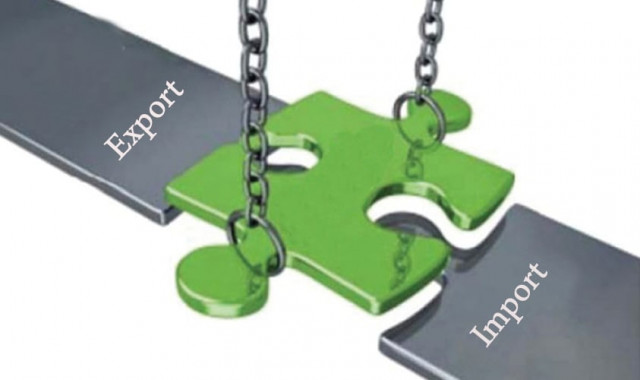Growing gap: Imports outpace exports as trade deficit grows
Chances of achieving deficit target grows grim keeping in view the data for July.

As imports outpace the growth in exports, the trade deficit widened over 6% in the first month of the fiscal year. PHOTO: FILE
Pakistan’s external trade took a sluggish start in the first month of the new fiscal year as exports grew marginally while imports grew at a faster pace, highlighting the difficulties that the country may have to face in balancing external accounts.
The latest trade figures released on Friday by the Pakistan Bureau of Statistics (PBS) underlined the sluggish start of the new fiscal year as compared to the ambitious projections made by the Ministry of Planning and Development in the annual plan for the fiscal year 2013-14.
As imports outpace the growth in exports, the trade deficit widened over 6% in the first month of the fiscal year.
Exports grew 2.7% year-on-year in July, showing a constant low growth rate. The country exported $2.1 billion worth of goods, compared to $2.05 billion last July, according to the PBS. Imports grew 4.2%, as the import bill clocked in at $3.8 billion, $152 million higher over last year July’s import bill.
The trade deficit remained at $1.72 billion, 6.1% or $98 million higher over a year ago.
In the last fiscal year, ended on June 30, the trade deficit had widened to $15.2 billion. The country had exported $24.5 billion worth of goods while its imports were valued at $45 billion.
In the annual plan, which was published just 18 days before the close of the fiscal year, the Ministry of Planning and Development hoped at touching $25.2 billion export receipts, while projecting imports at $40.4 billion for the last fiscal year.
On this basis, the national planners have projected a 5.1% growth in exports and 7% growth in imports for the current fiscal year. After exports fell below revised estimates, the country now requires 8.5% growth rate in exports to achieve the target of $26.6 billion.
The imports for the new fiscal year have been projected at $43.3 billion, while the trade deficit has been estimated at $16.7 billion.
Any shortfall in exports and higher than the estimated imports will cause problems in financing the current account deficit – the gap between external receipts and payments – particularly at a time when the country is set to return $6.5 billion in this fiscal year to multilateral lenders.
The current account deficit for this year has been estimated at $2.9 billion or 1.1% of the gross domestic product.
The ambitious export projections have been made despite the fact that the balance of payments position will remain under pressure due to external debt repayments including repayments to the IMF, declining trend of exports, rising international oil prices and weak financial inflows.
Monthly statistics
The monthly trade statistics depict a different scenario than the yearly figures. The trade deficit in July contracted 1.4% over June due to a contraction in both imports and exports. The exports fell 4.7% in July over the last month, while imports fell 3.2%, data from PBS shows.
Published in The Express Tribune, August 17th, 2013.
Like Business on Facebook, follow @TribuneBiz on Twitter to stay informed and join in the conversation.


















COMMENTS
Comments are moderated and generally will be posted if they are on-topic and not abusive.
For more information, please see our Comments FAQ